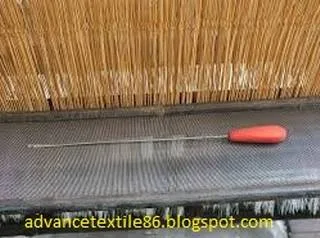Drawing-in process
In the drawing-in process, each end of the warp was separated through the dents of the reed and the eyes of the healds,
in the order indicated by the draft. The drawing-in process comes
just after the preparation of the weaver’s beam. The weaver’s beam is obtained
from sectional warping or sizing. The drawing-in process mainly
consists of two processes. The first process is called drafting and the second
process is called denting. It is mostly performed manually but in large-scale
textile industries, automatic drawing-in process machines
are used, where more productivity is required. When the drop wires closed are used, the ends are drawn through the drop wires before the heald eye.
The drawing-in process is applied for the execution of a new fabric design on the
loom. When the fabric design is regularly repeated, a warp tying (knitting) process is applied to change a loom beam. The tying process is done manually or
with the help of a knitting machine.
A. Drafting: A process of passing the end through the eye
of heald wire or harness according to the draft is called drafting. When the
draft is executed manually, two people do it. The person who selects the ends
and presents them for drawing is called a reacher. The person who draws the ends
through the eye of heald wire with the help of a drawing hook is called the
drawer.
B. Denting: When
the drafting of the ends is completed, these ends are passed through the dent
of the reed. We can say that “denting is the process of passing the ends
through the dents of reed according to the denting order of the fabric to be
woven”. It can be performed by a single person or two-person. In the case of
two persons, one person selects the ends and presents them to the other person
who passes these ends through the dents of the reed.











0 Comments